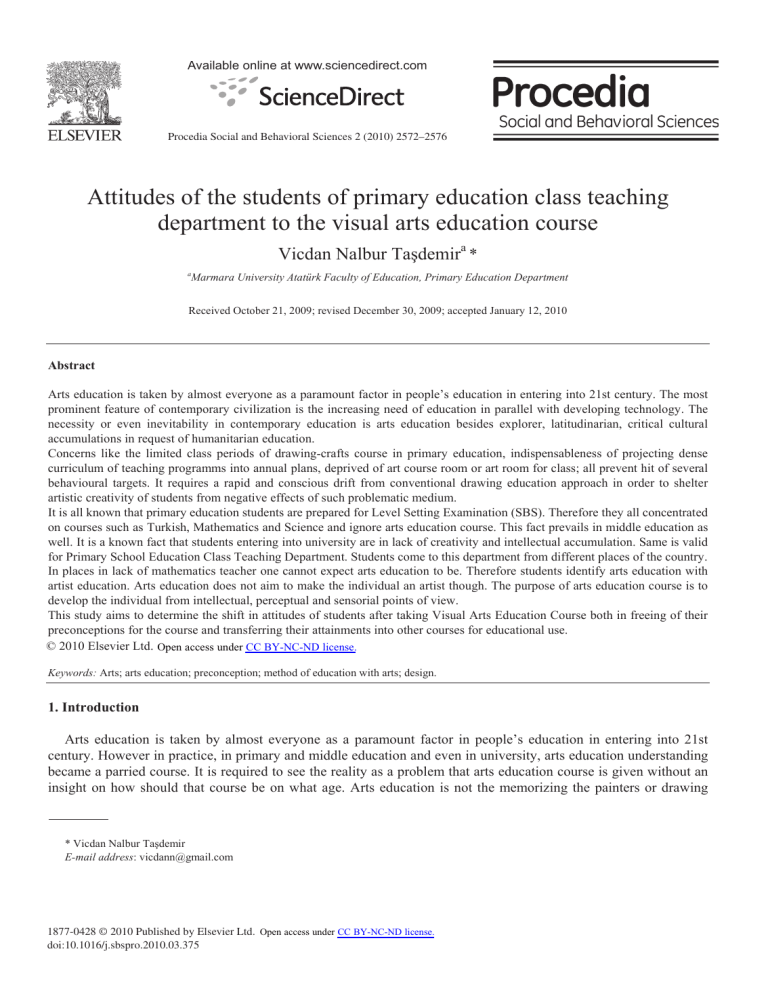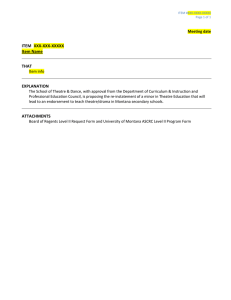
Available online at www.sciencedirect.com Procedia Social and Behavioral Sciences 2 (2010) 2572–2576 Attitudes of the students of primary education class teaching department to the visual arts education course Vicdan Nalbur Taúdemira * a Marmara University Atatürk Faculty of Education, Primary Education Department Received October 21, 2009; revised December 30, 2009; accepted January 12, 2010 Abstract Arts education is taken by almost everyone as a paramount factor in people’s education in entering into 21st century. The most prominent feature of contemporary civilization is the increasing need of education in parallel with developing technology. The necessity or even inevitability in contemporary education is arts education besides explorer, latitudinarian, critical cultural accumulations in request of humanitarian education. Concerns like the limited class periods of drawing-crafts course in primary education, indispensableness of projecting dense curriculum of teaching programms into annual plans, deprived of art course room or art room for class; all prevent hit of several behavioural targets. It requires a rapid and conscious drift from conventional drawing education approach in order to shelter artistic creativity of students from negative effects of such problematic medium. It is all known that primary education students are prepared for Level Setting Examination (SBS). Therefore they all concentrated on courses such as Turkish, Mathematics and Science and ignore arts education course. This fact prevails in middle education as well. It is a known fact that students entering into university are in lack of creativity and intellectual accumulation. Same is valid for Primary School Education Class Teaching Department. Students come to this department from different places of the country. In places in lack of mathematics teacher one cannot expect arts education to be. Therefore students identify arts education with artist education. Arts education does not aim to make the individual an artist though. The purpose of arts education course is to develop the individual from intellectual, perceptual and sensorial points of view. This study aims to determine the shift in attitudes of students after taking Visual Arts Education Course both in freeing of their preconceptions for the course and transferring their attainments into other courses for educational use. © 2010 Elsevier Ltd. Open access under CC BY-NC-ND license. Keywords: Arts; arts education; preconception; method of education with arts; design. 1. Introduction Arts education is taken by almost everyone as a paramount factor in people’s education in entering into 21st century. However in practice, in primary and middle education and even in university, arts education understanding became a parried course. It is required to see the reality as a problem that arts education course is given without an insight on how should that course be on what age. Arts education is not the memorizing the painters or drawing * Vicdan Nalbur Taúdemir E-mail address: vicdann@gmail.com 1877-0428 © 2010 Published by Elsevier Ltd. Open access under CC BY-NC-ND license. doi:10.1016/j.sbspro.2010.03.375 Vicdan Nalbur Taşdemir / Procedia Social and Behavioral Sciences 2 (2010) 2572–2576 2573 nature-mort, portrait. It should be programmed as courses to educate individuals those claim his/her own culture, distinguishing, protecting, critical inquiring his/her own values in architecture, paintings, music, crafts, rituals, traditions and conventions, own artworks of his/her historical legacy or world legacy, and those have had sociology, psychology and history of civilization. It is all known that our legacy Turkish architecture is spoiled and characterless buildings are made instead since 1970s. Same deterioration lives in music, painting, crafts and other branches of arts. Children get know Harry Potter in prior to knowing their own music and tales. Universal does not become before national. How explicit we could teach Turkish movie, literature, drawings and architecture in arts education? We rendered Turkish art artificial in political discrimination so polarized and spoiled it. The deterioration in arts education also affected painting-crafts courses in schools negatively. A preconception is formed that course among students because of teachers deprived of arts education cold not combine arts education as per development stages of the students. Student class teachers come to arts education with deep preconceptions. They see that course a talent course only. In order to make students free of those preconceptions first basics of arts education is established, then infrastructure on their own architecture, drawing, music and literature is held and then interdisciplinary arts education is carried. In the practices arranged according to Gardner’s multiple intelligence we studied affects of social political and economical conditions affecting art works like literature, movie, theatre, architecture, drawing, sculpture, children’s literature in decays in our history through movies, theatre, dance and design. Short film studies are carried on issues like lost values, alienation, migration, culture and family. Studies are done on subjects like mores, neighbourhood, neighbouring regions, and migration in dance theatre and self-expression groups. Designs, theatre posters, fable books, place of colours in daily life (interior design) are studies as well. Surely, it is not possible to carry all these studies in class considering that lesson periods are short. So, extracurricular researches are done in groups mostly concentrated on dance theatre because they developed all their projects improving their team spirit. Same is valid for short film studies. Our educators are required to provide our children and youth talk freely and express themselves easily. This is possible first of all with provision of wider perspective and correct usage of body language (Nalbur Taúdemir 2007). Our body, prior to having a consciousness, becomes a vehicle that impose meaning for our thoughts those are indicators of our conscious after studying for comprehending body language. Thereby we use our body as a channel for our emotional and attitudinal expressions besides our oral expressions. In other words, we fully put forward ourselves (Nalbur Taúdemir 2003). Eye moves, mimics, gestures, body moves besides distances and sitting arrangements are all important in effective use of body language. Hundreds of types of glances have as many messages to counterpart (Aytaú 2003). Studies on the subject emphasize as a scientific fact that 55% of communication is done through body language (Thomson 2002). These studies provide them critical thinking and point of view. Meeting students from different geographies in common projects help them to develop “our” concept. Those projects are analyzed in tables below. 1.1. Problem Student class teachers’ ruling out adequate visual arts education in their primary education and middle education and their possessing deep preconceptions for the course is the problem. 1.2. Purpose Forming interdisciplinary connections among dance theatre, short film, experimental film, performance and visual design works studied at visual arts education course and bring them critical thinking and intellectual point of view in regard of the course. 1.3. Importance x Enhancing intellectual accumulations of student teachers x Providing arts education for student teachers appropriate with most of their age 2574 Vicdan Nalbur Taşdemir / Procedia Social and Behavioral Sciences 2 (2010) 2572–2576 x Providing student teachers an interdisciplinary art education parallel with constructivist approach x Bringing critical thinking ability to students through arts education of student teachers 1.4. Assumptions Study is carried with a group of 128 each students at 5th semester in class teaching department. Questions are adequate to measure visual arts education efficacy and attitude of student teachers toward the course. 1.5. Model of the Study Open-end questions were asked and qualitative data analyze is done in the study. 1.6. Tables Study tables are at below. 1. Did you take Visual Arts Education Course during your primary education? Answers Yes No Total Subjects 10 118 128 Percentage 7,8 92,2 2. Did you take Visual Arts Education Course during your middle education? Answers Yes No Total Subjects 10 118 128 Percentage 7,8 92,2 3. Did you have preconceptions in regard of Visual Arts Education Course before you take it at Class Teaching Department? Answers Yes No Somewhat Total Subjects 43 25 48 128 Percentage 43,0 19,5 37,5 4. Is there any similarity between the Visual Arts Education Course you take at Class Teachers Department with those you took at your primary education and middle education? Answers Yes No Somewhat Missing reply Total Subjects 3 86 14 25 128 5. If yes to above, please write down those similarities 1. Design: Three subjects replying ‘yes’ reported that they find similarities with design 2. Sculpture: 3. Dance Theatre: 4. Short Film: Percentage 2,3 67,2 10,9 %19,5 2575 Vicdan Nalbur Taşdemir / Procedia Social and Behavioral Sciences 2 (2010) 2572–2576 6. Is there any change in your self confidence after you took Visual Arts Education? Answers Yes No Somewhat Total Subjects 86 9 33 128 Percentage 67,2 7 25,8 7. Which of the following issues in Visual Arts Education contributed mostly to your self confidence? Issue Dance theatre Documentary film Short film Sculpture Design Subject Percentage 88 68,8 5 3,9 20 15,6 5 3,9 10 7,8 Theories in Fine Arts Education 0 0 8. Could you form inter disciplinary connection among works you carried? Answers Yes No Somewhat Total Subjects 80 10 38 128 Percentage 62,5 7,8 29,7 9. Did you find Visual Arts Education Course difficult? Answers Yes No Somewhat Total Subjects 71 11 46 128 Percentage 55,5 8,6 35,9 10. Did you gain team formation ability with Visual Arts Education Course? Answers Yes No Somewhat Total Subjects 82 15 31 128 Percentage 64,1 11,7 24,2 2. Conclusion Arts enable the individuals to from connections between artistic creativity and artistic perceptions, to criticize them and gather results, and evaluate these results and communicate them. Individual develops various solutions alone since artistic activity is an individual activity and enhances his/her self confidence in that communication. Approaches developed in artistic expression medium could also be developed for daily life problems. Thus, students gain ability to develop better and extraordinary solutions, and habit to overcome difficulties. Art requires mental, emotional, technical or aesthetic activities and through these requirements it stimulates individual for progress generally. One of the resultant tables shows that the preconception of students on seeing the course as a talent course was changed after they took the course. Situation in Table 3, positive answers (existence of preconception) ‘yes’ and ‘somewhat’ add to 80,5% that indicates inability-to-do shifts to ability-to-do with positive answers (improved self confidence) ‘yes’ and ‘somewhat’ add to 93%. Greatest contribution to self confidence, as reported in Table 7, is attained with dance theatre (68,8%) and short film (15,6%) add up to 84%. Documentary film, sculpture and design are rather individualistic works. The preference on dance theatre and short film depends both on being individualistic work and their team work feature. The positive answers of inter disciplinary connection forming, ‘yes’ and ‘somewhat’ add to 92%, held in Table 8 shows that students gain abilities like critical thinking and intellectual accumulation transferrable through other courses with sociological, psychological, economical and other points of view. 2576 Vicdan Nalbur Taşdemir / Procedia Social and Behavioral Sciences 2 (2010) 2572–2576 References Aytaú, G. (2003). “Okullarda drama ve tiyatro e÷itimi,” Dosya: Yaúamda ve E÷itimde Tiyatro, Bilim ve AkÕm AydÕnlÕ÷Õnda E÷itim Dergisi, March, 4 (37) http://yayim.meb.gov.tr/yayimlar/sayi37/aytas.htm Nalbur Taúdemir, V. (2003). Okul öncesi erken çocuklukta geliúim ve e÷itimde yeni yaklaúÕmlar, (Bildiri KitabÕ), Ed.: Müzeyyen Sevinç, Morpa Kültür YayÕnlarÕ, østanbul. Nalbur Taúdemir, V. (2007). ølkö÷retim ça÷Õna genel bir bakÕú, (Bildiri KitabÕ), Ed.: Ayla Oktay and Özgül Polat Unutkan, Morpa Kültür YayÕnlarÕ, østanbul. Thomson, P. (2002). Secrets of communication, Trans.: Metin YurtbaúÕ, Arion YayÕnevi, østanbul.



